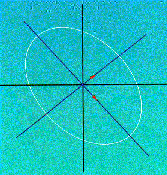

View the course syllabus.
View the "Instructor's
Policies."
View the "Guidelines for Written
Work."
View the
assignments
for this course.
View the "Linear
Algebra Course Objectives."
View the
links
to class sessions and other resources for this course.
OBJECTIVES: To develop the theory of vectors, matrices, and inner products, with emphasis on concepts and techniques used in geometry and physics.
PREREQUISITE: A second course in Calculus (MATH 202).
TEXT: "Linear Algebra and Its Applications," (Third Edition-Update) by David C. Lay; Addison-Wesley Publishing Company, 2006
TOPICS / CLASSES:
Chapter 1 Linear Equations / 14
Systems of linear equations: existence, uniqueness, elementary row
operations; Gauss-Jordan row reduction and echelon forms; vector equations;
linear independence; linear transformations; applications of linear systems.
Chapter 2 Matrix Algebra / 9
Matrix operations; inverse of a matrix; characteristics of invertible
matrices; subspaces of Rn.
Chapter 3 Determinants / 5
Introduction to determinants; properties of determinants; Cramer's
rule, volume, and linear transformations.
Chapter 4 Vector Spaces / 6
Vector spaces and subspaces; null spaces, column spaces, and linear
transformations; linearly independent sets and bases; coordinate systems;
dimensions of a vector space; rank; change of basis
Chapter 5 Eigenvalues and Eigenvectors / 7
Eigenvectors and eigenvalues; the characteristic equation; diagonalization;
eigenvectors and linear transformations; complex eigenvalues
Chapter 6 Orthogonality and Inner Product / 6
Inner product, length, and orthogonality; orthogonal sets; orthogonal
projections.
Optional Topics, Review, Tests, Group Work
/ 13
Including but not restricted to: Gram-Schmidt process; least squares
problems; applications in computer graphics; discrete dynamical systems
COURSE ACTIVITIES:
The course is built on a variety of activities: lectures, discussions, homework exercises, in-class activities, and group discussions.
Notes: Students are expected to take, and organize, class notes.
EVALUATION:
Tests ............................................................50%
(Best two of three tests; no make-up tests.)
Homework & Quizzes...................................25%
(No late papers accepted.)
Final Exam ...................................................25%
(10:45 am on Wednesday, December 16)
View the "Guidelines for Exercise Assignments."
View the "Guidelines for Interpreting Grades on Written Work."
Guidelines for Exercise Assignments
Out of class study, preparation, and work on assignments is a very important part of this course. Although you should attempt all assigned exercises, written solutions are only required for exercises in parentheses. You are invited to place solutions for exercises identified by an asterisk (*) on the chalk board prior to the start of class for optional credit.
Each time you write up an assigned exercise, focus not only on solving the problem, but also on how you solve the problem. If you are able to solve the problem, carefully communicate the steps in your solution process and clearly state your conclusion. If you feel you cannot solve the problem, describe in detail the process you used in attempting to find a solution. In general, pretend that you are writing the narrative for another student who is confused by the problem and would like to know how you solved it.
Each assignment you submit must be enclosed in a cover sheet employing
a prescribed format. Information on
"The Prescribed Format for Assignment Cover Sheets" can be found by
following the following link.
The Prescribed Format for Assignment Cover Sheets (Internet Explorer)
Guidelines for Interpreting Grades on Written Work
5, Excellent. Your responses to the assigned exercises/problems are correct and complete and you have clearly and correctly communicated the processes and techniques used to solve the exercises/problems. The paper is near, attractive, and well-organized and you have included appropriate diagrams, identified all variables introduced, and clearly stated, and verified, your conclusions.
4, Good. Your responses are reasonably correct and complete and your explanations of the processes and techniques used are fairly clear. However, some aspect may not be as complete, correct, clear, neat, or well organized as possible.
3, Satisfactory. Some of your responses may not be complete in some aspect, or have some errors, or lack clarity or supporting evidence. However, you do seem to understand most aspects of the assignment and posses most of the skills necessary to complete the assignment. Perhaps your work is not as neat and well organized as it should be.
2, Needs Improvement. Your responses are incomplete, unclear, lacking in style, or some major errors exist.
1, Unsatisfactory. You have not completed the assignment in a manner consistent with the guidelines. However, it looks like you have tried to do some of the assigned exercises.
0, Unsatisfactory. Does not meet minimum acceptable standards for evaluation. Paper not evaluated.